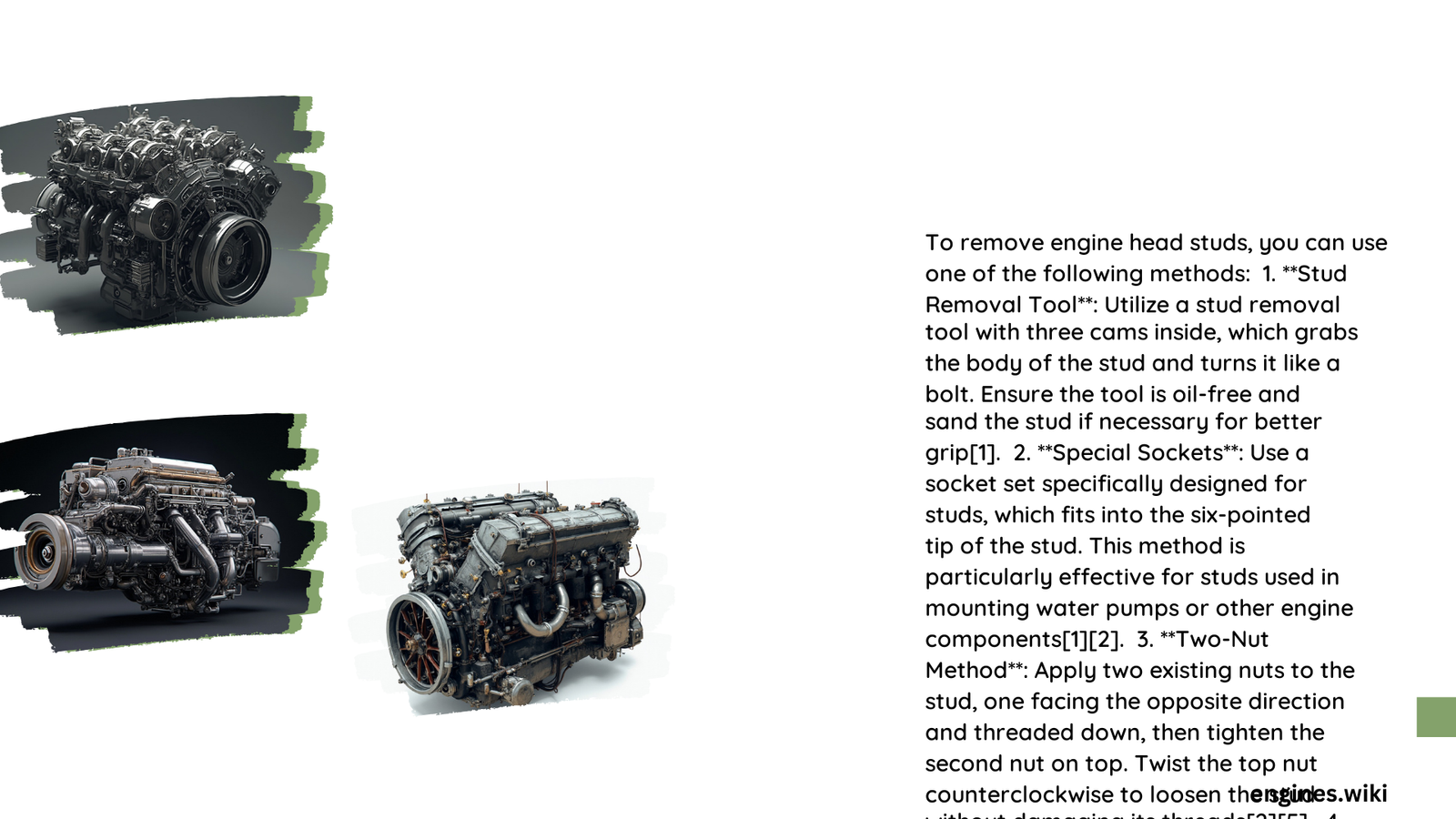Removing engine head studs is a critical task in engine maintenance and repair. This process requires careful planning, the right tools, and proper techniques to avoid damaging the engine block or breaking the studs. This guide will walk you through the various methods, tools, and considerations for successfully removing engine head studs, ensuring you can tackle this challenging task with confidence.
What Are the Most Effective Methods for Removing Engine Head Studs?
There are several methods to remove engine head studs, each with its own advantages and challenges:
- Double Nut Method
- Stud Extractor Tools
- Heat and Penetrating Oil Technique
Double Nut Method
This method is cost-effective and requires minimal specialized tools:
- Thread two nuts of the same size onto the stud
- Tighten them against each other
- Use a wrench to turn the bottom nut counterclockwise
- The top nut will pull the stud out as it turns
Pros:
– Inexpensive
– Requires minimal specialized tools
Cons:
– Time-consuming
– May not work on severely corroded studs
Stud Extractor Tools
Specialized tools designed for stud removal:
- Metric Stud Remover
- Impact Stud Puller
- Snap-On Dowel Stud Remover
These tools grip the stud tightly and use leverage or impact force to remove it.
Pros:
– More efficient than the double nut method
– Effective on stubborn studs
Cons:
– More expensive
– May require additional tools like an impact wrench
Heat and Penetrating Oil Technique
This method is often used in conjunction with other removal techniques:
- Apply penetrating oil to the stud and surrounding area
- Heat the area around the stud with a heat gun or torch
- Allow to cool, then attempt removal with chosen method
Pros:
– Helps loosen stubborn or corroded studs
– Can be used with other removal methods
Cons:
– Requires careful application of heat to avoid damage
– May not be suitable for all engine types
What Tools Are Required for Engine Head Stud Removal?

To successfully remove engine head studs, you’ll need the following tools:
- Wrench set
- Socket set
- Two nuts (for double nut method)
- Stud extractor tool
- Impact wrench or ratchet
- Penetrating oil (e.g., PB Blaster, WD-40)
- Heat gun or torch
- Safety glasses and gloves
How Do You Prepare the Engine for Head Stud Removal?
Proper preparation is crucial for successful stud removal:
- Clean the area around the studs
- Apply penetrating oil to the studs and let it soak for several hours or overnight
- If using heat, ensure the area is free from flammable materials
- Wear appropriate safety gear
What Are the Common Challenges in Removing Engine Head Studs?
Several issues can complicate the stud removal process:
- Corrosion: Studs may be seized due to rust or corrosion
- Limited access: Some studs may be difficult to reach
- Risk of breakage: Applying too much force can cause studs to snap
- Thread damage: Improper removal can damage the engine block threads
How Do You Deal with Broken Studs During Removal?
If a stud breaks during removal:
- Use a left-hand drill bit to drill into the remaining stud
- Apply a stud extractor to remove the broken piece
- If unsuccessful, you may need to drill out the stud and re-tap the hole
What Are the Specific Torque Specifications for Different Engines?
Torque specifications vary by vehicle make and model. Here are some examples:
| Engine Model | Torque Specification |
|---|---|
| Porsche 911 | 40-50 Nm (30-37 ft-lbs) |
| Honda CB350K4 | Refer to manufacturer’s manual |
| Ford F-150 5.4L | 100 ft-lbs + 90° turn |
Always consult your vehicle’s service manual for accurate torque specifications.
How Long Does It Take to Remove Engine Head Studs?
The time required for stud removal can vary:
- Double Nut Method: 2-4 hours
- Stud Extractor Tools: 1-3 hours
- Severely corroded studs may take significantly longer
Factors affecting removal time include:
– Number of studs
– Stud condition
– Accessibility
– Method used
What Safety Precautions Should Be Taken During Stud Removal?
Safety is paramount when working on engines:
- Wear safety glasses and gloves
- Use caution when applying heat
- Ensure proper ventilation when using penetrating oils
- Use the correct tools for the job
- Follow manufacturer’s guidelines for tool usage
How Can You Prevent Damage to the Engine Block During Stud Removal?
To protect the engine block:
- Use the correct size tools
- Apply force gradually and evenly
- Avoid over-tightening extractors
- Clean threads thoroughly after removal
- Inspect for damage before installing new studs
By following these guidelines and using the appropriate tools and techniques, you can successfully remove engine head studs while minimizing the risk of damage to your engine. Remember to always consult your vehicle’s service manual and take necessary safety precautions throughout the process.
References:
1. Pelican Parts Forum
2. YouTube – How to remove studs Tools Tips and tricks
3. Honda Twins Forum
